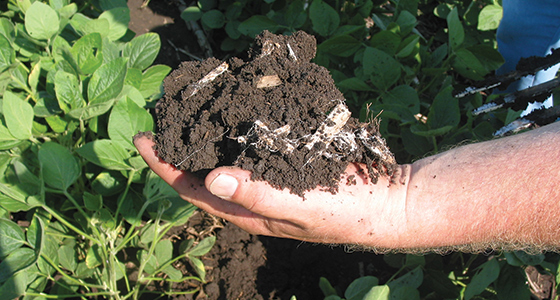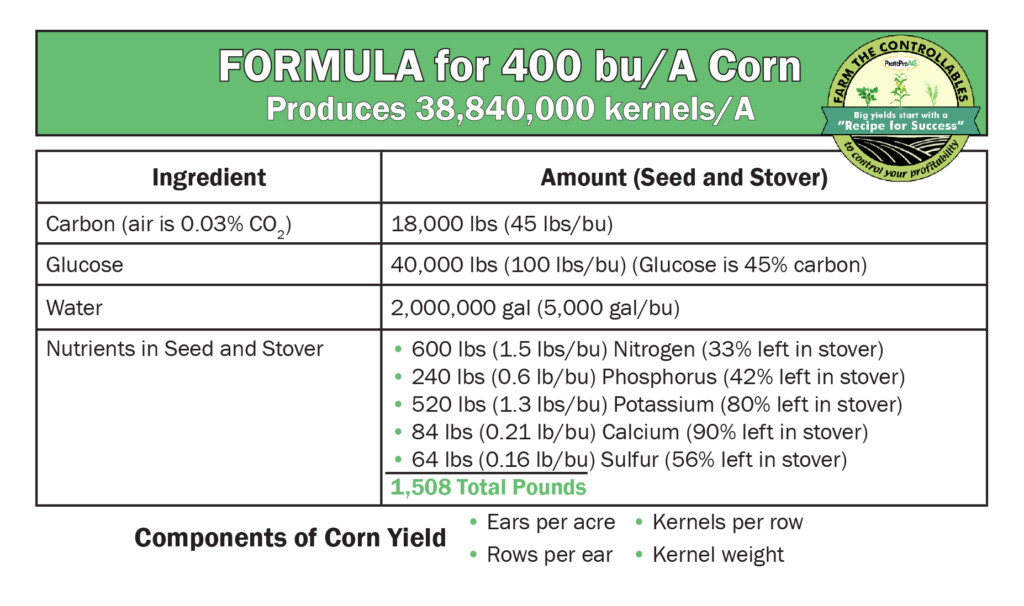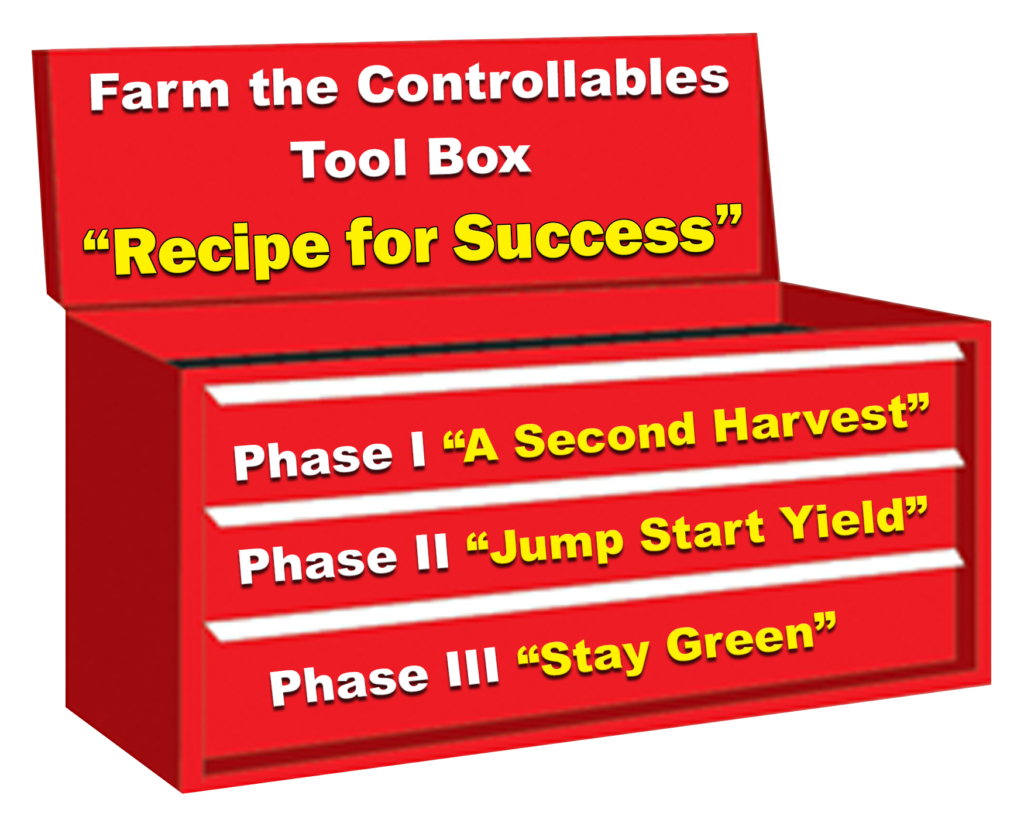Carbon Farming
Often-Overlooked Nutrient Boosts Crop Production
Want an opportunity to cut your fertilizer bill, control erosion, boost soil health and resilience, and improve your crops’ ability to endure extreme weather conditions? It’s time to take a new look at carbon.
“Carbon is a foundational building block of every nutrient in the soil and is essential for crop production,” said Dr. Jim Ladlie, founder and CEO of ProfitProAG.
About 45% of plant mass is made up of carbon. “Carbon must be managed properly, since it’s one of the most limiting resources in crop production,” Ladlie said.
Carbon plays many key roles in natural cycles that can enhance crop production. “Beneficial bacteria and fungi love plant-derived carbohydrates and need soft carbon sources like root exudates,” said Al Toops, chief agronomist with BTI Ag LLC. The microbes open nutrient pathways in the soil that enhance nutrient uptake into the plants. After the growing season, plant residue decomposition starts the cycle over again.
Soil carbon is “black gold” on a farm. It’s also something that farmers can readily influence. Stored soil carbon is a bit like a bank account, Toops said. While certain farming practices allow farmers to grow this bank account, withdrawals come from soil erosion and other factors. “What’s in your carbon bank account?” Toops asked.
Carbon provides many key benefits
The importance of carbon can’t be overemphasized when it comes to producing healthy crops with stronger yield potential, Ladlie said. The advantages of carbon include:
- Improved nutrient availability and uptake. Many nutrients in the soil must be processed by microbes before plants can take up the nutrients. Beneficial fungal species break down carbon residue and move it to the soil, explained Toops, who champions the BeCrop® Test, which sequences strains of DNA to determine what microbes are in the soil and also measures various factors related to carbon. Beneficial microbes, especially mycorrhizal fungi, are essential in releasing valuable nutrients that are locked up in the soil. When these natural pathways work properly, crops can tap into the goldmine of free nutrients stored in the soil.
- Reduced soil density. Soil compaction is no asset to efficient crop production. It can make seedbed preparation more difficult, hinder water infiltration into the soil, and contribute to poor root growth, which reduces crop yield through poor water and nutrient uptake. An abundance of carbon-rich soil organic matter, in contrast, provides a great environment for all sorts of life to thrive in the soil. “Soil microbes are like little birds that are always hungry and looking for food,” Toops said. As beneficial microbes and earthworms move through the soil to take in carbon as their source of energy, this helps break up soil density. Less compaction in the soil encourages better plant root development. An improved root system fosters better nutrient and water absorption. This also aids the soil’s capacity to withstand erosion.
- Improved resilience to drought and extreme rainfall. Extreme weather events pose serious challenges to agriculture, but carbon helps here, too. Carbon-rich soils can effectively absorb rainfall to control runoff and erosion. They can also retain water to support crops more effectively during dry conditions. This contributes to greater yield stability, Ladlie said.
Managing carbon can boost the bottom line
Managing carbon properly can also boost farmers’ bottom line in terms of:
- The potential for lower crop input bills. Carbon-rich soils enhance nutrient cycling by boosting beneficial soil microbes that help make soil nutrients available to plants. If nutrient pathways are blocked, however, it’s a serious loss. Toops has seen cases where BeCrop soil tests show 2,700 – 7,000 pounds of nitrogen (N) per acre, but only 40 to 60 pounds of N per acre are available to the crop. “I’ve also seen situations where 500 to 800 pounds of phosphorus (P) per acre were available, but only 60 to 120 pounds were available to the crop,” he added. When those nutrient pathways are functioning, however, that means more nutrients available to the crop, which can lower fertilizer bills.
- Reduced soil erosion and water runoff. Carbon sources help feed beneficial soil biology that drives the water cycle. “If your carbon cycle isn’t functioning properly, your water cycle isn’t either,” Toops said. This is linked to soil aggregates. Soil particles are arranged together to form aggregates, which are held together by organic matter. Soil microorganisms play an important role in the formation and stabilization of aggregates. Well-aggregated soil lets water enter the soil profile, while small pores within the aggregates hold water tightly enough to keep it around, but loosely enough for plant roots to take it up. Well-aggregated soil can absorb rainfall better, which helps control runoff and soil erosion.
- Long-term productivity. Building healthy soils and managing carbon effectively means playing the long game. Increasing organic matter and soil carbon happens over time. Making more deposits in the carbon bank account than withdrawals will keep agricultural soils productive through the years.
Use carbon-friendly farming practices
Managing carbon is crucial for long-term sustainability in agriculture, Ladlie noted. A variety of farming practices can help farmers reach this goal, including minimizing tillage and using cover crops, which help add organic matter to the soil and control soil erosion. “Cover crops can build 0.1% to 0.2% organic matter a year,” Toops said.
Fall residue management is another key practice, Ladlie added. It’s an important part of ProfitProAG’s 3-Phase Recipe for Success. “Our Recipe for Success isn’t a cookie-cutter plan,” Ladlie said. “It’s tailored to your acres, whether you raise soybeans, corn, small grains, forages or cover crops.”
- Phase I Residue Management. This “second harvest” focused on efficient breakdown of crop residue to improve soil health and boost nutrient retention/availability, nitrogen fixation, water infiltration, and carbon release to feed the crop during the growing season, while reducing residual insect and disease pressure. The key benefit is improved nutrient cycling from the crop residue, which can help lower your fertilizer bill.
- Phase II At-Plant. Jump start your yield, and get your crop off to a strong start with early-season plant health and vigor. Biological seed coatings and the right starter package supply key nutrients to seedlings and enhance plant health all season-long. “Putting an inoculant in-furrow when you plant is a good way to add more biology,” Toops said. Establishing healthy plants below and above ground is critical to maximizing the crop’s genetic yield potential. ProfitProAG’s seed coatings use biology, rather than chemicals, to help control crop disease and insect pests.
- Phase III In-Season. Help your crop stay green to the finish for maximum yield potential. This phase helps mitigate plant stress, which is critical when the reproductive phase of yield development begins. Foliar application of nutrients, energy and stress-reducing technology builds resilience and uniformity in a crop-production system. The end result is increased seed numbers, weight and nutrient density in grains. Forages show improved nutrient content, energy, taste, storability and reduced mycotoxins.
The Recipe for Success works in conjunction with carbon farming practices to help maintain soil quality, instead of depleting its life-giving properties. “Carbon is an important plant nutrient and should be treated like one,” Ladlie said. “The better you understand carbon, the better crop producer you’ll be.”
Here are 5 things every farmer must know about carbon to produce healthier crops that provide more nutritious feed for livestock and supply more nutrient-dense food for people:
1. Carbon is key to nutrient cycling in the soil.
All forms of carbon are important. When managed properly on the farm, carbon helps:
• Reduce soil erosion
• Enhance water infiltration for less runoff
• Protect water quality
• Decrease soil compaction
• Improve soil tilth and structure
• Boost beneficial biological activity in the soil
• Reduce fertilizer inputs
• Increase soils’ capacity to handle manure and other wastes
Proper carbon management also lends greater resiliency to soils, which helps crops better manage weather-related stresses like dry conditions. “Soil high in carbon is rich in organic matter that releases nutrients to crops,” says Don Reicosky, a retired U.S. Department of Agriculture (USDA) Agricultural Research Service (ARS) soil scientist who has been a guest speaker at ProfitProAG meetings. “Soil organic matter also acts like a ‘sponge’ for water retention and release to plants. Carbon is our greatest water management tool.”
2. Focusing on CASH farming pays off.
“Conservation Agriculture Soil Health (CASH) farming supports soil organic carbon,” Reicosky says. “True conservation is carbon management,” adds Reicosky, who notes that CASH farming works when you have continuous residue cover, minimal soil disturbance and diverse crop rotations and/or cover crops. CASH farming follows four principles of soil health: 1.) Keep the soil covered at all times. 2.) Disturb the soil as little as possible. 3.) Incorporate as many different species of plants and animals as practical. 4.) Keep living roots in the soil as long as possible.

3. You are not in control—nature is.
CASH farming is based on biological principles that let you farm in harmony with nature. Ladlie is concerned, however, that too many farmers are taking a less sustainable approach by working soil when it’s too wet, planting too early and relying primarily on high salt fertilizers and fungicide chemicals to keep their crop healthy during the growing season, without focusing enough attention or effort on building soil health. “Then they wonder why their corn is dying prematurely in September and leaving test weight behind,” he says. “If you want to farm sustainably, you need to understand carbon cycling and why it’s the heart of building soil organic matter and improving soil health.”

4. Carbon management helps you grow high-yielding, nutrient-dense food.
When carbon cycling is working properly in your soils, you’ll raise healthier crops with greater potential to produce higher test weights, stronger yields and more nutritious food. Want to know if you’re managing carbon properly on your farm?
Try the Brix test, which measures the percent of dissolved sugars in plant sap. These sugar levels are correlated with the plant’s food-producing efficiency (photosynthesis) and the nutrition contained in the plant, including protein, mineral content and more.
A Brix Test involves a simple, inexpensive tool called a refractometer to assess Brix levels in plants, right in the field. Brix levels are measured on a scale from 0 (poorest) to 32 (best). “Your goal is to produce crops with a Brix measurement of 12 or higher,” Ladlie says. “Anything below eight is not worthy of reproducing or eating. In fact, it’s nature’s garbage. Unfortunately, many of the crops we test, including corn, soybeans and forage, have Brix levels of four to six.” (Measuring Brix levels during the growing season is a key part of ProfitProAG’s Farming the Controllables system, which we’ll talk about more in a minute.)
5. Carbon is the future of farming—literally.
If you want to build greater resiliency, sustainability, consistency and profitability into your farming operation, you must make carbon management a priority. “Our future is tied to how much carbon we can keep in the soil,” Reicosky says. “Our big job is capturing the carbon with plants and getting it into the soil to contribute to the soil organic matter build up, which enhances water holding capacity and nutrient cycling for subsequent crops.”


"Recipe for Success"

The “Recipe for Success” makes carbon management simple
Maybe you like what you’re hearing, but you’re feeling a bit overwhelmed, too. You want to manage carbon more effectively, but where do you start?
It’s all about controlling the controllables, Ladlie says. That’s why ProfitProAG has created the “Recipe for Success” program that is customized to each farm’s needs. “The “Recipe for Success” isn’t a cookie-cutter plan,” Ladlie says. “Each “Recipe for Success” is tailored to your acres, whether you raise corn, soybeans, small grains, forages or cover crops.”
Try the "Recipe for Success" if you want to:
- Build healthier soils, which produce healthier crops that nourish healthier livestock.
- Cut your fertilizer bill, by unlocking nutrients that are already in your crop residue and soil.
- Boost your crops’ resilience and yield potential, no matter what Mother Nature brings.
The “Recipe for Success” is a three-phase plan that helps you control the controllables too manage carbon more effectively:

- Phase I Residue Management. Don’t put your sprayer away too early in the season! Residue management is a “second harvest” in the fall focused on the efficient breakdown of crop residue to improve soil health and boost nutrient retention/availability, nitrogen fixation, water infiltration, and carbon release to feed the crop during the growing season. It also helps reduce residual insect and disease pressure. You start this important process when you spray our residue management product (which is packed with beneficial microbes) on your crop residue after harvest. The key benefit is improved nutrient cycling from the crop residue break down, which can help lower your fertilizer bill. You have valuable nutrients just sitting out there in your stover, which can take years to break down. Residue management makes this process more efficient and cost-effective.
- Phase II At-Plant. Jump start your yield, and get your crop off to a strong start with early-season plant health and vigor. Biological seed coatings and the right starter package supply key nutrients to seedlings and enhance plant health all season long. Establishing healthy plants below and above ground is critical to maximizing the crop’s genetic yield potential.
- Phase III In-Season. Stay green to the finish! This phase helps mitigate plant stress, which is critical when the reproductive phase of yield development begins. Foliar application of nutrients, energy and stress-reducing technology builds resilience and uniformity in a crop-production system. The end result is increased seed numbers, weight and nutrient density in grains. Forages show improved nutrient content, energy, taste, storability and reduced mycotoxins. (Remember the Brix test we mentioned earlier in this article? This is where it comes in.)

The “Recipe for Success” isn’t guesswork. We encourage growers to use the Haney soil health test to measure what’s working. Like traditional soil tests, the Haney Test measures the key macro- and micronutrients needed for crop growth. The Haney Test differs from traditional soil tests, however, since it also evaluates various soil health indicators, such as soil respiration (to learn more about the Haney Test, click here).
“If you want to grow higher-yielding crops with better grain quality, it’s essential to understand proper carbon management and work with these natural cycles,” Ladlie says. “Carbon management provides the building blocks your crops need to succeed. Take a look at how the “Recipe for Success” can help you put these building blocks in place on your farm.”